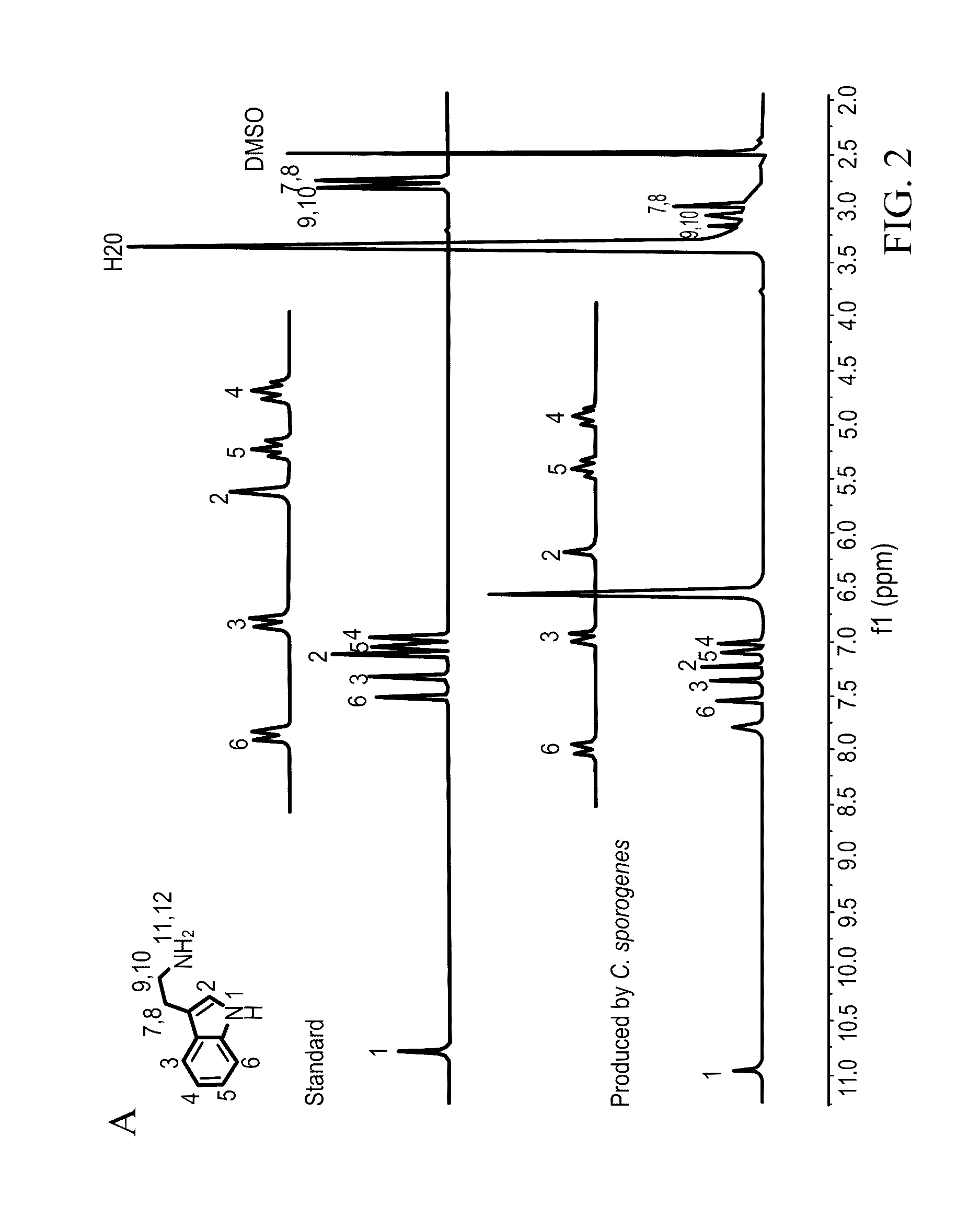Methods and materials for using ruminococcus gnavus or clostridium sporogenes to treat gastrointestinal disorders
a technology of ruminococcus gnavus and clostridium sporogenes, which is applied in the field of bacteria compositions, can solve the problems of largely withdrawn from the market of 5htr4 agonists and systemic cardiac side effects
- Summary
- Abstract
- Description
- Claims
- Application Information
AI Technical Summary
Benefits of technology
Problems solved by technology
Method used
Image
Examples
example 1
Characterization of Gut Microbiota Decarboxylases that Can Produce the Neurotransmitter Tryptamine
[0049]Clostridium sporogenes was found to be capable of decarboxylating tryptophan (trp) to tryptamine (FIG. 1A). Trp decarboxylase enzymes from C. sporogenes, Ruminococcus gnavus, along with additional decarboxylases identified via phylogeny-informed screen were characterized. In addition, structural determinants of Trp selectivity in the R. gnavus decarboxylase were explored, and it was found that at least 10% of the human population harbors one of these enzymes.
Bacterial Growth Conditions
[0050]Clostridium sporogenes ATCC 15579 was grown in reinforced clostridium medium (BD) supplemented with MEM Vitamins (GIBCO) and incubated anaerobically at 37° C. Ruminococcus gnavus ATCC 29149 was grown in brain heart infusion medium (BD) supplemented with yeast extract (5 g / L) and hemin (5 g / L) and incubated anaerobically at 37° C. For the qualitative cell-based decarboxylation assay, cultures we...
example 2
Acetate and Butyrate, but not Tryptamine, Reproducibly Modulate Tphl mRNA Expression in BON Cells, a Model of Enterochromaffin Cells
[0092]To determine if tryptamine can reproducibly and consistently stimulate serotonin synthesis in vitro tryptophan hydroxylase 1 (Tphl) mRNA expression was assessed in an alternate EC-like cell model-BON cells by qRT-PCR. Cells were plated at 1×10̂5 per ml and grown to 90% confluency in 12-well culture plates. Culture wells were then treated (in triplicate) with tryptamine in media for 6 hours, fixed in RNA Protect (Qiagen) and subjected to qRT-PCR.
[0093]None of the tested tryptamine concentrations (1 μM, 5 μM, 10 μM, and 20 μM) reproducibly showed a significant alteration of Tphl mRNA levels. Treatments with acetate of 10 mM, 30 mM, and 50 mM induced 2.5-fold, 3.2-fold and 2.2-fold Tphl expression, respectively (P<0.001; One-way ANOVA; 2-3 independent experiments). The effect of another short chain fatty acid, butyrate, on Tphl expression was also te...
example 3
Open Organ Bath System Used to Measure Intraluminal Pressure of Mouse Colonic Segments Ex Vivo Following Infusion of Tryptamine Vs. Vehicle
[0095]Preparations of full-thickness colonic segments (˜1.5 cm) were allowed to equilibrate in 37° C. Kreb's-jacketed organ baths with their distal ends opening to a pressure transducer and maintained under basal pressure of 5-cm column of vehicle (RL). The proximal end was closed during pressure recordings but opened to allow luminal infusion of vehicle or tryptamine in solution (100 μM, 1 mM and 3 mM; 10 minutes per treatment; n=5-7 mice).
[0096]Contractile frequency was not significantly different comparing tryptamine treatments with vehicle controls; however, there was a trend toward increased frequency in segments treated with luminal 1 mM tryptamine compared to controls (5.9±0.8 vs 4.1±0.6; P=0.15). Mean contractile amplitude and contractile magnitude, as measured by area under the curve, were also not significantly different between control...
PUM
| Property | Measurement | Unit |
|---|---|---|
| pH | aaaaa | aaaaa |
| pH | aaaaa | aaaaa |
| pH | aaaaa | aaaaa |
Abstract
Description
Claims
Application Information
 Login to View More
Login to View More - R&D
- Intellectual Property
- Life Sciences
- Materials
- Tech Scout
- Unparalleled Data Quality
- Higher Quality Content
- 60% Fewer Hallucinations
Browse by: Latest US Patents, China's latest patents, Technical Efficacy Thesaurus, Application Domain, Technology Topic, Popular Technical Reports.
© 2025 PatSnap. All rights reserved.Legal|Privacy policy|Modern Slavery Act Transparency Statement|Sitemap|About US| Contact US: help@patsnap.com



